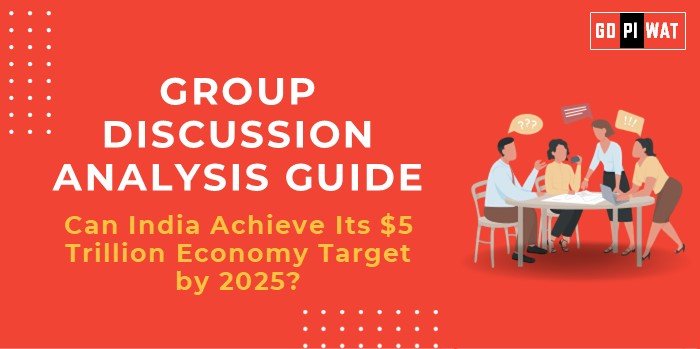📋 Group Discussion (GD) Analysis Guide: Can India Achieve Its $5 Trillion Economy Target by 2025?
🌐 Introduction to the Topic
- 📌 Opening Context: “India’s ambition to become a $5 trillion economy by 2025 has become a cornerstone of its economic vision, shaping national policies and global perceptions.”
- 📌 Topic Background: This target was announced by Prime Minister Narendra Modi in 2019, aiming to solidify India’s position as a global economic powerhouse. The timeline aligns with structural reforms in taxation (GST), digitalization (Digital India), and infrastructure development.
📊 Quick Facts and Key Statistics
- 📈 GDP Size: As of 2023, India’s GDP stands at approximately $3.57 trillion, making it the world’s fifth-largest economy.
- 📉 Growth Rate: The economy grew by 7.2% in 2023, surpassing major economies.
- 📊 Sectoral Contributions:
- 🌾 Agriculture: Approximately 16% of GDP.
- 🏭 Industry: Around 29% of GDP.
- 💼 Services: Contributes about 55% of GDP.
- 🚢 Exports: India’s total exports (merchandise and services combined) in FY 2023-24 were estimated at USD 776.68 billion, with a target of $900 billion for FY 2024-25.
- 💰 FDI Inflows: Recorded at $71 billion in FY 2023.
🏆 Achievements
- 📱 Digital Economy: The Unified Payments Interface (UPI) has revolutionized digital transactions, processing over 11.5 billion transactions monthly as of March 2024.
- 🏗️ Infrastructure Development: Initiatives like the National Infrastructure Pipeline aim to invest $1.4 trillion in infrastructure projects.
- 🛠️ Manufacturing Growth: Production Linked Incentive (PLI) schemes have boosted manufacturing, particularly in electronics and pharmaceuticals.
⚠️ Challenges
- 📉 Economic Growth Rate: Achieving a $5 trillion economy by 2025 requires a sustained annual growth rate of 12.5%, a challenging feat given global economic conditions.
- 🔍 Unemployment: Significant joblessness among educated youth.
- 📊 Inflation: Fluctuating inflation impacts purchasing power and savings.
- 📉 Fiscal Deficit: Projected at 5.9% of GDP for FY 2023-24, limiting public spending capacity.
🌍 Global Comparisons
- 🇨🇳 China: Achieved a $5 trillion GDP in 2010 with an average growth rate of around 10% over the preceding decade.
- 🇺🇸 United States: Reached the $5 trillion mark in the late 1980s, driven by a robust industrial and digital ecosystem.
💡 Strategic Arguments for Group Discussions
- Proponents’ View: “India’s record exports, digital economy growth, and infrastructure projects provide a strong foundation to reach the $5 trillion goal.”
- Opponents’ View: “Given the current global economic slowdown and India’s structural challenges, the $5 trillion target by 2025 is overly ambitious.”
- Balanced Perspective: “While India’s growth trajectory is promising, achieving the $5 trillion mark by 2025 will require addressing macroeconomic risks and fostering inclusive development.”
📊 Updated SWOT Analysis
- Strengths:
- 💻 Robust digital economy driven by UPI and e-commerce.
- 👩🎓 Young, dynamic workforce eager to contribute to growth.
- Weaknesses:
- 📉 Persistent unemployment and underemployment.
- 🌾 Rural-urban divide in access to resources and infrastructure.
- Opportunities:
- 🔋 Expand renewable energy projects to enhance energy security.
- 🤖 Leverage AI and machine learning for economic transformation.
- Threats:
- 🌍 Geopolitical risks affecting trade.
- 🛡️ Cybersecurity vulnerabilities in an increasingly digital economy.
📈 Future Outlook and Recommendations
- ⚙️ Sectoral Growth Focus:
- Accelerate PLI schemes in manufacturing, electronics, and pharmaceuticals.
- Promote Make in India initiatives to reduce imports and boost exports.
- 🌐 Digital and Financial Inclusion:
- Expand BharatNet to ensure 100% rural broadband penetration.
- Strengthen MSMEs as engines of employment and innovation.
- 📊 Macroeconomic Stability:
- Maintain a balanced fiscal approach to manage inflation and deficits.
- Create buffers against global headwinds through strategic reserves and diversification.
- 🤝 Partnerships for Growth:
- Encourage private-public partnerships in infrastructure.
- Expand global trade networks through FTAs (Free Trade Agreements).
📄 Conclusion
While India has made significant strides in digitalization, infrastructure development, and manufacturing, achieving the $5 trillion economy target by 2025 appears ambitious. Sustaining high growth rates amidst global economic uncertainties, addressing unemployment, and managing inflation are critical challenges that need to be addressed. A more realistic timeline, coupled with focused policy interventions, may be necessary to realize this economic aspiration.


